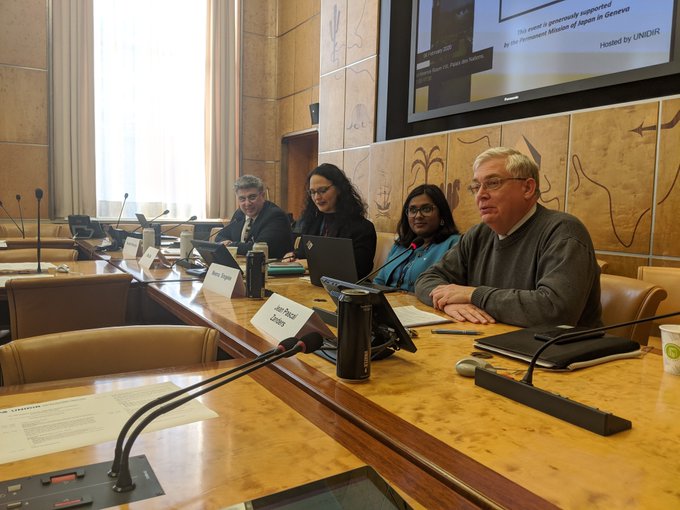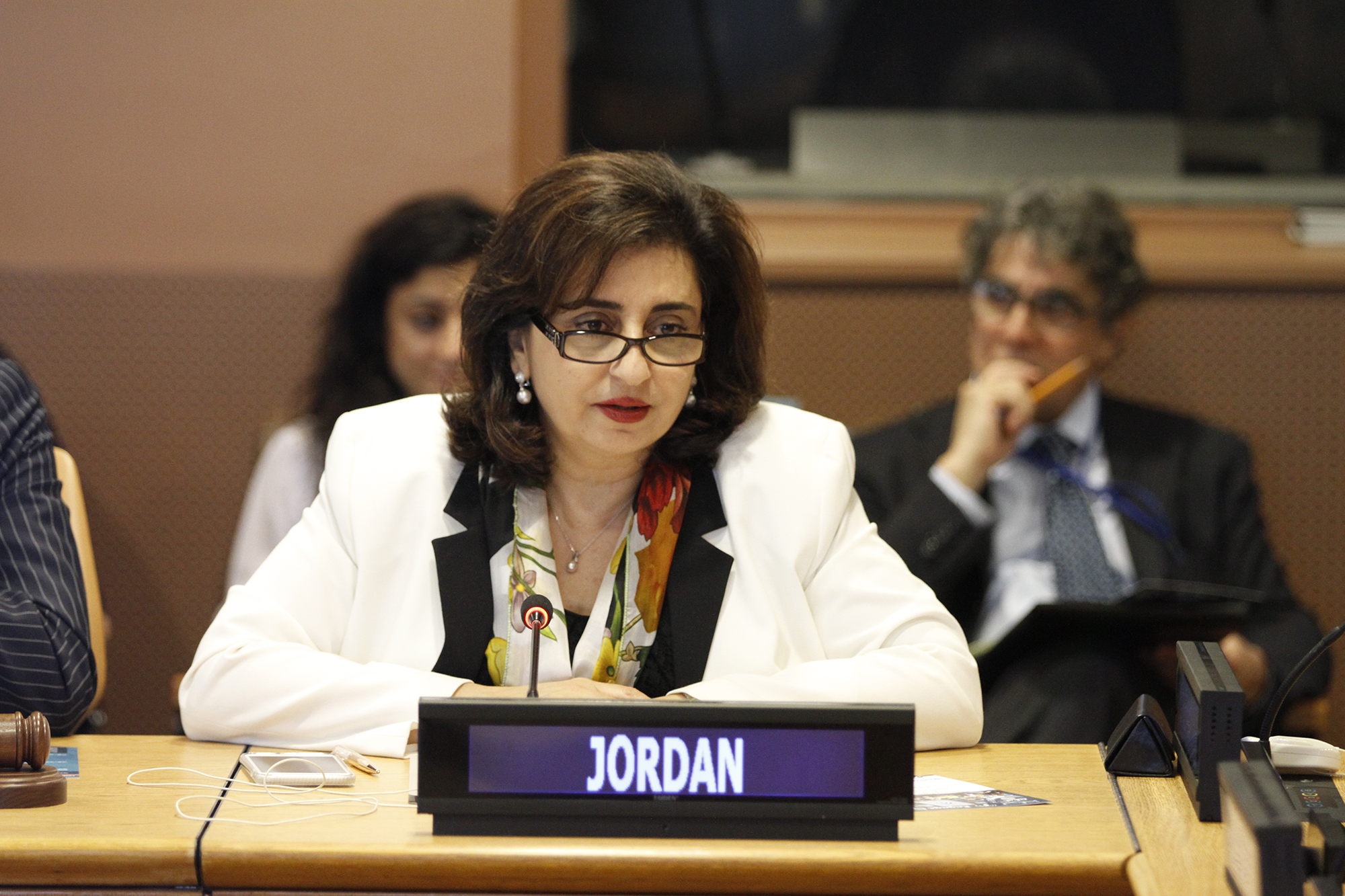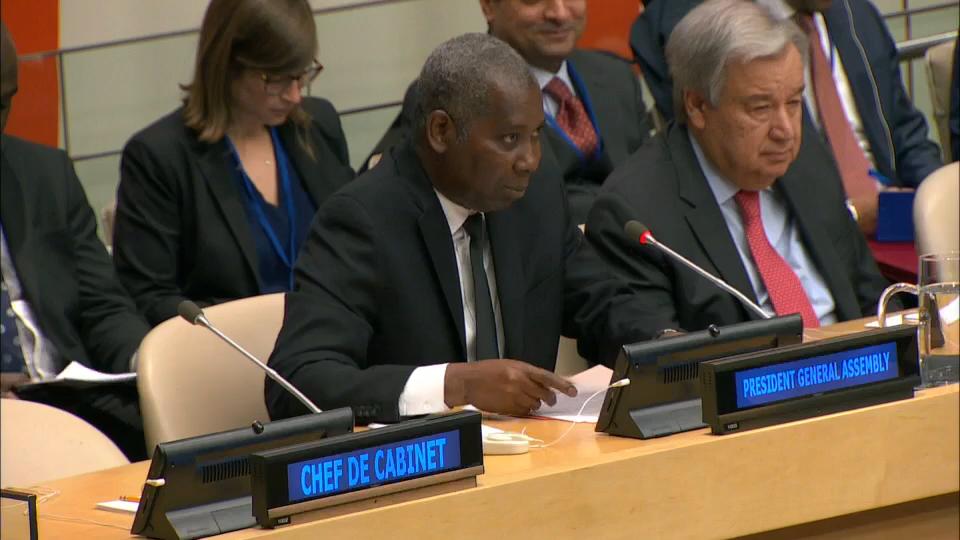A Middle East Zone Free from Non-conventional Weapons (1)
Part 1: A new process to disarm the Middle East
In November 2019 a conference at the United Nations in New York marked a fresh round of diplomatic efforts to eliminate non-conventional arms – essentially nuclear weapons, and to a lesser extent chemical and biological weapons (CBW) – from the military arsenals in the Middle East. The previous initiative died in 2015 as the review conference (RevCon) of the 1968 Nuclear Non-Proliferation Treaty (NPT) failed to agree on a consensus document.
The new series of annual meetings takes place outside the NPT RevCon cycle, which consists of a quinquennial RevCon preceded by three preparatory committee (PrepCom) meetings. This decoupling of discussions exploring how to set up a Middle East zone free of non-conventional weapons from the NPT at a minimum reduces the prospect that more technical deliberations fall foul of the political grandstanding whenever the region is on an NPT meeting agenda. It also creates an opportunity for expert or technical committees to address questions about CBW threats in the region separate from nuclear weapons as well as the NPT review cycle.
On 6 February the United Nations Institute for Disarmament Research (UNIDIR) with support from the Japanese Mission to the United Nations Office at Geneva organised the event ‘The Middle East Weapons of Mass Destruction Free Zone, 2020 NPT Review Conference, and Pathways Forward’ to discuss the new initiative, see which lessons can be drawn from past efforts to create a zone exempt from non-conventional weapons, and identify pathways forward.

I spoke to the question of how the participants in the new conference series could address CBW. This set of seven blog postings is based on my remarks and preparatory notes. Comments made during the event or more specifically in response to my presentation I have included in these blog pieces. Chatham House rules governed the meeting. Therefore, I cannot attribute certain views to specific participants.
Antecedents to the new initiative
On 22 December 2018, the First Committee of the United Nations General Assembly (UNGA) accepted Egypt’s proposal to convene ‘a conference on the establishment of a Middle East zone free of nuclear weapons and other weapons of mass destruction’ (Decision 73/546). The previous round of meetings had its immediate origin in a resolution adopted at the 1995 NPT RevCon. It formed part of the compromise to have that agreement’s duration extended indefinitely.
Three review conferences later, in 2010, parties to the NPT endorsed five practical steps to achieve such a zone, one of which proposed the organisation of a dedicated conference. However, disagreements over the agenda, who should be invited to attend, and whether the conference was to be a one-off gathering or the start of a process meant that the preparatory talks continued well into 2014. The conference was eventually abandoned. A new proposal submitted at the 2015 RevCon met with resistance from a few Western states, as a consequence of which the meeting ended without a final document.
A key novelty of the 1995 resolution was the expansion of the scope in earlier proposals for a nuclear weapon-free zone (NWFZ) for the Middle East to a zone exempt from all so-called Weapons of Mass Destruction (WMD). CBW thus entered the debates. Delivery systems, essentially ballistic missiles, were also to be considered under the proposal and the disarmament initiative had to be verifiable.
It is worth recalling that overall, 1995 was year of relative optimism for disarmament and arms control. Besides the success of the NPT review conference, signatories were preparing the entry into force of the Chemical Weapons Convention (CWC), which eventually happened in April 1997. The parties to the Biological and Toxin Weapons Convention (BTWC) embarked on negotiations for a legally binding protocol that, among other things, aimed to equip the agreement with verification machinery like that foreseen in the CWC. In a separate set of developments, the UN Special Commission (UNSCOM) set up after the 1990–91 Gulf War was having breakthroughs in unravelling Iraq’s biological weapons (BW) programme. It was also progressing with the elimination of the country’s chemical weapons (CW) and ballistic missile capacities. UNSCOM proved the worth of deep-reaching and persevering verification.
The mid-1990s saw progress in other fields of bilateral, regional and multilateral weapon control too. These included the negotiation and subsequent ratification of the 1993 Strategic Arms Reduction Treaty II, the implementation of the 1990 Treaty on Conventional Aimed Forces in Europe, the achievement of the 1996 Comprehensive Nuclear Test Ban Treaty, and the establishment of two new NWFZs in Southeast Asia (1995 Treaty of Bangkok) and Africa (1996 Treaty of Pelindaba).
The Middle East did not share in that cautious optimism. The Arms Control and Regional Security (ACRS) working group sputtered to an end by the middle of the decade. Created as one of five working groups at the Madrid Middle East Peace Conference (30 October – 1 November 1991), ACRS plenary and intersessional meetings ran from May 1992 until December 1994. While it ultimately provided useful insights into how arms control and disarmament might be structured in the region, it succumbed to three issues that have bedevilled almost all initiatives to reduce the risk and consequences of military confrontation in the Middle East: states invited to and excluded from the process; management of the process by states outside of the region; and perceived overall bias towards Israel. The setup also suffered from structural problems, notably the separation of the so-called multilateral process aiming at normalising relations between the participating states (Israel, Jordan, Lebanon, the Palestinian Authority as part of the Jordanian delegation, and Syria) and the arms control/disarmament dimension that focussed on nuclear weapons. The former aspect without progress on disarmament would have favoured Israel; the latter aspect without advancing on regional peace and security was seen as disadvantageous to Israel. (For detailed reviews, see Peter Jones, The Arms Control and Regional Security Working Group: still relevant to the Middle East?, July 2011; and Erzsébet N. Rózsa, Weapons of Mass Destruction in the Middle East and North Africa, November 2018).
The cautious optimism in the mid-1990s also took a severe battering later in the decade and the early 2000s when aggressive unilateralism replaced multilateralism and structured international cooperation. Moreover, internal turmoil began affecting many states in the Middle East and either led to the disposal of governments, coups or civil war, the consequences of which are still shaping the global and regional geopolitics of today. These factors, in addition to the multiple traditional geopolitical cleavages in the Middle East contributed to why the diplomatic engine cut out in 2015.
A series of annual meetings
The first meeting of conference called for in the decision by the UNGA First Committee took place from 18 to 22 November 2019. The report together with its annexed political declaration, as well as other meeting documents and statements are available from the conference web page. The Middle East Treaty Organisation (METO) Project, a non-governmental organisation that attended the conference, prepared a report for Reaching Critical Will.


Presently it remains unclear how the new initiative will evolve. Much of the debate took place behind closed doors. It appears that delegates were unable to adopt rules of procedure, worked on a procedural basis outlined by the chairperson, and will continue consultations on rules of procedure during the intersessional period leading up to the second meeting of the conference in November 2020. The political declaration adopted at the end of the week-long meeting expressed consensus of purpose.
From the 2018 decision and the first meeting of the conference, the following parameters appear clear:
- The conference will meet annually for a duration of 5 working days, starting on the third Monday of November;
- The series of annual meetings will continue until the conference concludes the elaboration of a legally binding treaty establishing a Middle East zone free of nuclear weapons and other weapons of mass destruction;
- Participation in the conference series is primarily limited to the 23 countries from the Middle East region as defined by the International Atomic Energy Agency (IAEA): Algeria, Bahrain, Comoros, Djibouti, Egypt, Iran (Islamic Republic of), Iraq, Israel, Jordan, Kuwait, Lebanon, Libyan Arab Jamahiriya (Libya), Mauritania, Morocco, Oman, Qatar, Saudi Arabia, Somalia, Sudan, Syrian Arab Republic, Tunisia, United Arab Emirates and Yemen;
- The three NPT depository states that sponsored the Resolution on the Middle East at the 1995 RevCon (Russia, United Kingdom and Unites States) are also to be invited in view of their responsibilities concerning the resolution’s implementation;
- Invitations are also extended to the two other nuclear weapon states recognised under the NPT (China and France) as well as relevant international organisations. The BTWC Implementation Support Unit (ISU), the Organisation for the Prohibition of Chemical Weapons (OPCW) and the IAEA were invited to attend the public sessions of the first conference and the UN Office for Disarmament Affairs has confirmed that they will receive invitations for the next meetings;
- In between conferences Middle Eastern countries will hold intersessional meetings. The exact format is unclear at present and will likely depend on progress at the annual meeting, but special or technical committees have not been ruled out.
- The Middle Eastern states claim ownership of the process and point out that countries external to the region will not determine who can and cannot be included in the process (as was the case for ACRS and the conference that was supposed to be held after the 2010 RevCon).
The relationship between the meetings and the NPT RevCon (process) has not yet been outlined. Even though there are several voices from the region in favour of the UN Secretary-General (UNSG) reporting to the RevCon, the 2018 decision establishing the meeting series only requires the UNSG to report annually to the UNGA.
From the available public statements, the first meeting of the conference was high in political content. The absence of Israel and the United states was deplored and there appears to have been some discussion on the focus of the meeting series that broadly reiterated positions heard over the past decade and more.
Place of CBW in the new process
Nuclear weapons have always been central to the idea of regional disarmament. The UNGA adopted an Iranian proposal to establish a NWFZ in the Middle East in 1974, a goal Israel acceded to six years later. At the time of Iran’s initiative, three out of the four existing zones that prohibit the deployment of non-conventional weaponry were uninhabited: Antarctica (entry into force: 1961), space (1967) and the seabed (1972). The fourth, the Treaty of Tlatelolco (1967 – date of first ratification as the treaty entered into force for each state individually) was the only one covering an inhabited continent.
With political and geopolitical changes over the next two decades, the ambition of the NWFZ in the Middle East appeared increasingly to boil down to elements: pressure Israel to join the NPT and have its nuclear installations placed under IAEA safeguards, on the one hand, and have Israel dismantle its undeclared nuclear weapon stockpile, on the other hand. Any progress on regional security or any other form of weapon control came to depend on Israel moving on both demands. The NPT, today still the only global multilateral agreement in force placing limitations on nuclear weapon possession, became the main vehicle to advance the NWFZ project even though Israel is not a party to it.
As noted earlier, the 1995 NPT RevCon adopted Egypt’s proposal to expand the idea of a NWFZ to one of a zone exempt from all so-called WMD. The mandate for the current conference series is rooted in that resolution. As Decision 73/546 (2018) by the UNGA First Committee stipulates in paragraph (a):
(i) The conference shall take as its terms of reference the resolution on the Middle East adopted by the 1995 Review and Extension Conference.
(ii) The conference shall aim at elaborating a legally binding treaty establishing a Middle East zone free of nuclear weapons and other weapons of mass destruction, on the basis of arrangements freely arrived at by the States of the region.
The decision also acknowledges the place of CBW in the process in paragraph (c):
To request the International Atomic Energy Agency, the Organisation for the Prohibition of Chemical Weapons and the Biological Weapons Convention Implementation Support Unit to prepare the background documents necessary for the conference.
Both the BTWC ISU and the OPCW submitted the requested background documents to the 2019 meeting (BTWC ISU submission – OPCW submission). The BTWC ISU also delivered a statement to the conference.
While recognising the primary interest in nuclear disarmament, the key question is whether the participants in the new conference series will accord regional CBW disarmament – weapon elimination as well as the adoption of measures to prevent their development, acquisition, stockpiling and use – a meaningful place in their deliberations.
Presently, conference participants have advanced insufficiently with organising the structure of the meetings. They do not yet have a clear vision on the nature of the weapon-free zone for the Middle East, what verification will entail or whether there will be a regional seat to administer the treaty. They have questions as to whether the UNSG will be the most appropriate depository of the treaty. They need to find consensus on whether they intend to address nuclear, biological and chemical weapons in a single package or as separate arms categories, thereby recognising their different roles in military doctrine and their different legal frameworks in international law. And they also still have to decide whether the process will be purely political or whether they will create the space for considering the technical aspects of regional disarmament for each one of the arms classes. They do not shut out options, stressing that they still need to lay out a path forward, identify priorities and milestones, and sequence them into the future.
Thus far, we note that in his address opening the first meeting of the conference Ambassador Tijjani Muhammad-Bande (Nigeria), President of the 74th session of the UNGA, only mentioned nuclear weapons. UNSG António Guterres referred to CW only in the context of ‘meaningful accountability for the use of chemical weapons’ and thereby confused the objective of disarmament with that of criminal accountability under international humanitarian law. When pointing to the conference objectives, he totally ignored the biological dimension:
Serious deliberations on a Middle East zone free of nuclear, chemical and other weapons of mass destruction would be an opportunity for the States of the region to engage in direct dialogue on arrangements that could address their security requirements.
Dr Sima Sami Bahous (Jordan), Ambassador and President of the first session of the conference, merely used the WMD moniker in her closing statement to imply the need to address CBW too.
Despite this seemingly marginal interest in CBW for the future Middle Eastern zone free of non-conventional weapons, the current conference series outside of the NPT RevCon cycles offers a better prospect for meaningful discussions and solutions than previously. The next blog postings in this series will explore the opportunities and challenges to ensure that the regional risks of CBW threats and use – CW were and as I am writing, are part of conflicts in the Middle East – are banished once and for all.
